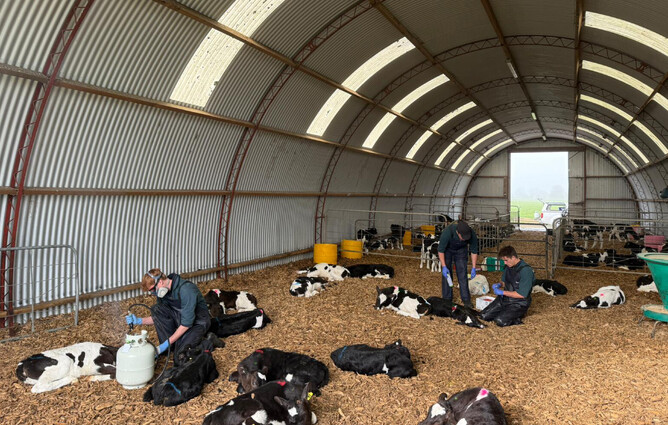Disbudding involves carefully and safely burning out the horn buds of calves. Removing the buds means they won’t grow sharp horns as an adult, helping prevent nasty injuries to herdmates and handlers. It's much less painful and stressful on the animal getting them done while they're young, as the buds are still only in the skin level.
At Vet Clinic Morrinsville, when we disbud calves we do it under sedation and give anti-inflammatory pain relief (Metacam), on top of using local anaesthetic.
Research has shown that adding local anaesthetic and anti-inflammatories, as well as sedation, creates better animal welfare outcomes. It's now considered industry best practice.
It provides plenty of benefits to your calves – the main one being it significantly decreases the cortisol (pain/stress hormone) levels in calves after the procedure, which leads to them getting back to eating and drinking faster, reducing a growth check. Sedating them also means a safer and more peaceful experience for the calves and for the people involved.
Disbudding is great time to vaccinate your calves too, as it limits the number of different stressful events they'll have to go through. Plus, being able to do this while they're sedated makes this job much easier.
Calves need to be protected against clostridial infections and leptospirosis. For broad coverage, we recommend using Covexin 10 for clostridial vaccination and Lepto 4-Way for leptospirosis protection.
Young calves are the most vulnerable age group for clostridial and leptospirosis infections, so vaccinating them as soon as possible is very important. Ideally, they would get their first Covexin 10 dose at two weeks old, followed by a booster after six weeks, when they would also get their first Lepto 4-Way dose. They then need a Lepto 4-Way booster another six weeks later.
So, when is the best time to get your calves disbudded?
Ideally, they would be done when they're just over two weeks old. Calves are old enough to be sedated at this age, and their buds will have just started to show and will be easy to remove. The older calves get, the harder they are to handle, plus their buds will get bigger and more difficult to remove.
Calf sheds are quickly filling up with heifer replacements – book in your calves for disbudding now, so you can secure your preferred date and time!
Here's some tips to help you get prepared when we're coming out to disbud your calves:
Don't give the calves milk for 4-6 hours prior to your appointment
Safely secure calves in pens of 15-20 calves maximum – if your mobs are larger, provide extra gates/fencing to separate them
Pens should be clean and dry, with enough space that's out of direct sunlight or rain
Mark special calves, i.e. bull calves that need castrated while we're there
Please have someone present at the calf shed when we're due to arrive
Advise us prior to arrival if there's any other jobs you'd like us to see to while we're there, i.e. a sick or lame cow at the milking shed
If you have any questions about disbudding or vaccinating your calves, or to talk through what will happen on the day, give our team a call.


